The Carboniferous is a geologic period and system of the Paleozoic that spans 60 million years from the end of the Devonian Period 358.9 million years ago (Mya), to the beginning of the Permian Period, 298.9 million years ago. The name Carboniferous means "coal-bearing", from the Latin carbō ("coal") and ferō, and refers to the many coal beds formed globally during that time.

The Devonian is a geologic period and system of the Paleozoic, spanning 60.3 million years from the end of the Silurian, 419.2 million years ago (Mya), to the beginning of the Carboniferous, 358.9 Mya. It is named after Devon, England, where rocks from this period were first studied.
Romer's gap is an example of an apparent gap in the tetrapod fossil record used in the study of evolutionary biology. Such gaps represent periods from which excavators have not yet found relevant fossils. Romer's gap is named after paleontologist Alfred Romer, who first recognised it. Recent discoveries in Scotland are beginning to close this gap in palaeontological knowledge.

Eureptilia is one of the two major subgroups of the clade Sauropsida, the other one being Parareptilia. Eureptilia includes Diapsida, as well as a number of primitive Permo-Carboniferous forms previously classified under Anapsida, in the old order "Cotylosauria".
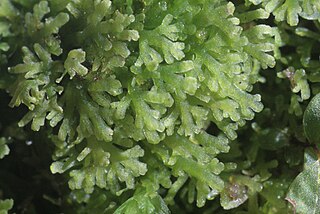
Metzgeriales is an order of liverworts. The group is sometimes called the simple thalloid liverworts: "thalloid" because the members lack structures resembling stems or leaves, and "simple" because their tissues are thin and relatively undifferentiated. All species in the order have a small gametophyte stage and a smaller, relatively short-lived, spore-bearing stage. Although these plants are almost entirely restricted to regions with high humidity or readily available moisture, the group as a whole is widely distributed, and occurs on every continent except Antarctica.
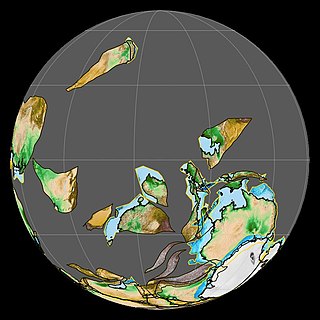
The Tournaisian is in the ICS geologic timescale the lowest stage or oldest age of the Mississippian, the oldest subsystem of the Carboniferous. The Tournaisian age lasted from 358.9 Ma to 346.7 Ma. It is preceded by the Famennian and is followed by the Viséan.

Arthropleura is a genus of extinct millipede arthropods that lived in what is now North America and Europe around 345 to 290 million years ago, from the Viséan stage of the lower Carboniferous Period to the Sakmarian stage of the lower Permian Period. The species of the genus are the largest known land invertebrates of all time, and would have had few, if any, predators.

Megarachne is a genus of eurypterid, an extinct group of aquatic arthropods. Fossils of Megarachne have been discovered in deposits of Late Carboniferous age, from the Gzhelian stage, in San Luis, Argentina. The fossils of the single and type species M. servinei have been recovered from deposits that had once been a freshwater environment. The generic name, composed of the Ancient Greek μέγας (megas) meaning "great" and Ancient Greek ἀράχνη (arachne) meaning "spider", translates to "great spider", because the fossil was misidentified as a large prehistoric spider.

Rhizodus is an extinct genus of basal, finned tetrapodomorphs. It belonged to Rhizodontida, one of the earliest-diverging tetrapodomorph clades. Two valid species have been described, both of which lived during the Early Carboniferous epoch. The type species R. hibberti is known from the Viséan stage of the United Kingdom, whereas the species R. serpukhovensis is from the Serpukhovian of Russia. Some fossils referred to the genus Rhizodus have also been found in North America.

Whatcheeriidae is an extinct family of tetrapods which lived in the Mississippian sub-period, a subdivision of the Carboniferous period. It contains the genera Pederpes, Whatcheeria, and possibly Ossinodus. Fossils of a possible whatcheeriid have been found from the Red Hill locality of Pennsylvania. If these remains are from a whatcheeriid, they extend the range of the family into the Late Devonian and suggest that advanced tetrapods may have lived alongside primitive tetrapod ancestors like Hynerpeton and Densignathus. They also imply that a very long ghost lineage of whatcheeriids lived through Romer's gap, a period during the Early Carboniferous conspicuously lacking in tetrapod remains.
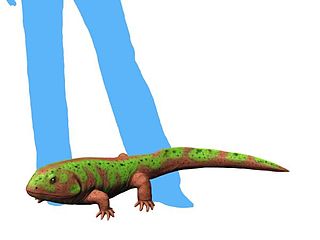
Pederpes is an extinct genus of early Carboniferous tetrapod, dating from 348 to 347.6 Ma in the Tournaisian age. Pederpes contains one species, P. finneyae, 1 m long.

Helenodora is an extinct basal onychophoran or lobopodian genus known from the Carboniferous Carbondale Formation of Illinois. The only known species described is H. inopinata. The ecology of this animal is not well known, but it is thought that it may have lived on land and/or underwater.
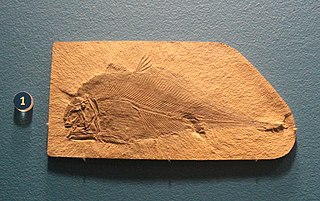
Allenypterus is a genus of a prehistoric lobe-finned fish which lived during the Bashkirian stage of the Late Carboniferous period, 318 million years ago). Fossils have been discovered in Bear Gulch Limestone, Montana, USA.
Archichthys is a genus of rhizodont lobe-finned fish that lived during the Carboniferous period. Holotype of this fish was found in Northumberland, UK.

Platyrhinops is an extinct genus amphibamid temnospondyl from the Late Carboniferous of Ohio and the Czech Republic. It is known from many partial skeletons from the Linton site in Saline Township, Ohio and at least 6 partial specimens from the Nýřany site from the Nýřany Member of the Kladno Formation in the Czech Republic.
Coelostegus is an extinct genus of Late Carboniferous basal reptile known from Pilsen of Czech Republic. It is known from the holotype ČGH 3027, a partial skeleton of an immature individual. It was collected in the Nýřany site from the Nýřany Member of the Kladno Formation. It was first named by Robert L. Carroll and Donald Baird in 1972 and the type species is Coelostegus prothales. The most recent phylogenic study of primitive reptile relationships found Coelostegus to be the basalmost known eureptile.
Eusauropleura is an extinct genus of gephyrostegid reptiliomorph from the Pennsylvanian of Linton, Ohio. The type species and only species, Eusauropleura digitata, was first described by American paleontologist Edward Drinker Cope in 1868 as Sauropleura digitata. In 1930, paleontologist Alfred Romer placed the species in the new genus Eusauropleura. Romer considered S. digitata to be a reptile or a more primitive relative of reptiles, making it only distantly related to Sauropleura, which is a lepospondyl amphibian.

Eotetrapodiformes is a clade of tetrapodomorphs including the four-limbed vertebrates and their closest finned relatives, two groups of stem tetrapods called tristichopterids and elpistostegalids. The clade was named in 2010 by Michael I. Coates and Matt Friedman, and is defined as "the node-based clade arising from the most recent common ancestor of Eusthenopteron and Ichthyostega plus all of its descendants". It thus excludes the basalmost tetrapodomorphs, such as the rhizodonts and megalichthyiforms.
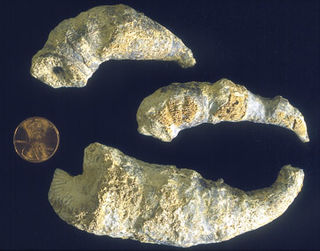
Caninia is an extinct genus of rugose coral. Its fossils occur worldwide from the Devonian to the Permian periods.

The Ganigobis Formation is a Late Carboniferous (Gzhelian) to Early Permian (Artinskian) geologic formation of the Dwyka Group in the ǁKaras Region of southeastern Namibia and the Northern Cape of South Africa. The widespread formation was deposited in the Aranos and Karoo Basins of southern Africa.














